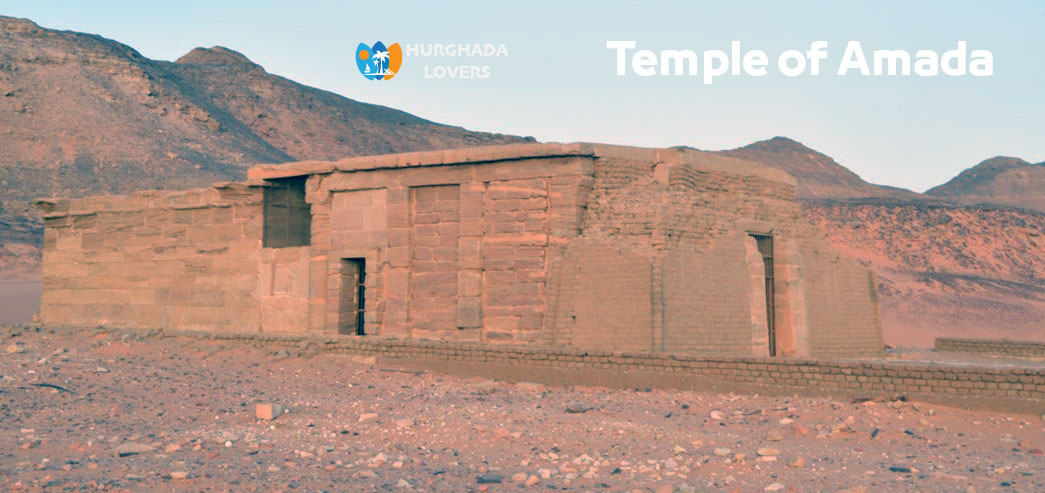Temple of Amada in Nubia, Aswan, Egypt | Facts, History of oldest Pharaonic temples, 18th dynasty Map, Entrance Fees, Opening Hours and more…
Facts of Amada Temple and the history of building the oldest pharaonic temples of the Eighteenth Dynasty on the shores of Lake Nasser, how much is the entrance ticket, opening times and more.
The Temple of Amda is one of the oldest Egyptian temples in the land of Nubia, to testify, along with other temples, to the greatness of the Pharaonic civilization. The views and drawings that were recorded on the walls of this temple reflect its strategic importance during the era of the New Kingdom.
Hurghada lovers Offer Luxury Hurghada to Luxor Tours | El Gouna to Luxor Tours | Makadi bay to Luxor Tours | Sahl Hasheesh to Luxor Tours | Soma bay to Luxor Tours.
Temple of Amada
Where is the temple intentionally located?
● A temple is deliberately located in southern Egypt, Aswan Governorate, on the banks of Lake Nasser, south of the High Dam and about 180 km away from it. The temple was removed from this site, about 2.5 kilometers away from its original site.
When was a temple built intentionally? And who built it?
● The construction of a temple was deliberately started in the period between 1550-1295 BC.
● That was during the eighteenth dynasty. It was built during the reign of three kings, Tuthmosis III, and during the reign of his son Amenhotep II, most of the main part of it was completed.
● After that, King Thutmose IV, one of the kings of the nineteenth dynasty, came and finished building it and adding modifications to it, such as the front pillars hall.
● The temple was subjected to a lot of destruction during the reign of King Akhenaten, so that King Seti I and King Ramses II, kings of the nineteenth dynasty, added restoration work to this temple.
What deity was deliberately worshiped in a temple?
● A temple was built intentionally to worship the god Amun Ra and Ra Hor Akhti.
● The inscriptions on the walls of this temple depict the king performing the rituals of worship, and some depict the king during his introduction to these two powerful deities.
● In the Coptic era, these drawings were covered with layers of plaster and a dome was built of mud bricks on the roof of the temple, turning the temple into a Coptic church.
Description of the Temple of Amada
● The entrance to the temple begins with the works of Tuthmosis IV, which is a gate made of stones. On the right side of this gate we find drawings of King Tuthmosis III, and on the left of it are inscriptions depicting King Amenhotep II performing worship to the god Ra Hor Akhti.
● When passing through the gate, we find that the temple consists of a wide courtyard surrounded by a wall of mud bricks. The courtyard ends with a porch whose roof rises with four columns. Eight other columns were added to it during the reign of King Thutmose IV, bringing the number to 12 columns.
● At the end of the temple is the Holy of Holies, and behind it there are rooms attached to the temple whose walls contain many hieroglyphic texts, scenes and historical events.
● The walls of a temple deliberately recorded many wars of the nineteenth dynasty, for example, we find on the rear walls the appearance of King Amenhotep II celebrating the success of his military campaigns on the Levant, and King Merneptah, son of Ramses II, recorded his victory in an attack on Egypt by a Libyan campaign.
● In addition to many drawings depicting the ceremonies of worshiping the god Amun and the god Ra Hor Akhti, such as presenting gifts and offerings to them.
Deliberately saving a temple
● After the construction of the High Dam in the 1960s, the water level in Lake Nasser rose, making the temple in danger of extinction. UNESCO included it in its campaign to save the heritage, and it was dismantled and rebuilt in another higher site, about 2.5 kilometers away from its original site. This campaign also included the Temple of Durr and the tomb of Banut.
● The process of deliberately rescuing a temple was difficult and threatening to the temple. The UNESCO budget was not enough to move the temple, which weighs about 600 tons and needs special devices to prevent the oscillation of stones and preserve them from fragmentation. Because of the severity of the impact.
How do you access a Temple of Amada?
● A temple can be visited intentionally by cruise ships that pass in Lake Nasser, and this trip is enjoyable, but it takes two days from Aswan to the temple.
● It can also be accessed by a private car through the Aswan-Abu Simbel road.
What is the price of a ticket to visit a Temple of Amada for the Egyptians?
● The fee for an adult temple visit ticket: 10 Egyptian pounds
● As for the fees for a ticket to intentionally visit a temple, it is: 5 Egyptian pounds
What is the price of a ticket to intentionally visit a temple for foreigners?
● The fee for a ticket to intentionally visit a temple for foreigners: EGP 70
● If the visitor is a foreign student, the entry fee is 35 Egyptian pounds.

